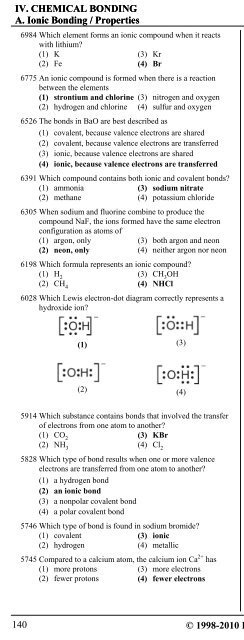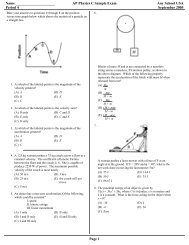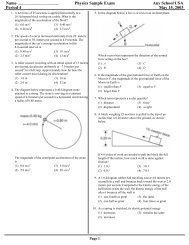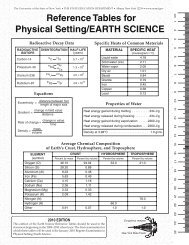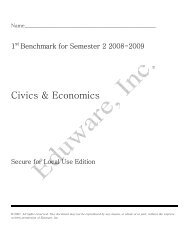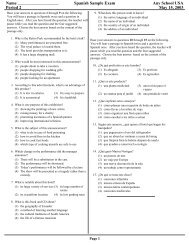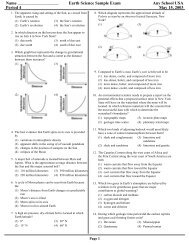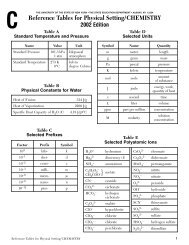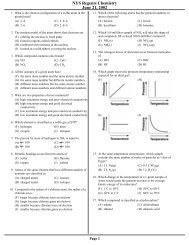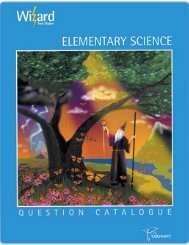Wizard Test Maker - Eduware
Wizard Test Maker - Eduware
Wizard Test Maker - Eduware
- No tags were found...
You also want an ePaper? Increase the reach of your titles
YUMPU automatically turns print PDFs into web optimized ePapers that Google loves.
IV. CHEMICAL BONDING 2. Bond TypesA. Ionic Bonding / Properties i. Ionic Bonding6984 Which element forms an ionic compound when it reactswith lithium?(1) K (3) Kr(2) Fe (4) Br6775 An ionic compound is formed when there is a reactionbetween the elements(1) strontium and chlorine (3) nitrogen and oxygen(2) hydrogen and chlorine (4) sulfur and oxygen6526 The bonds in BaO are best described as(1) covalent, because valence electrons are shared(2) covalent, because valence electrons are transferred(3) ionic, because valence electrons are shared(4) ionic, because valence electrons are transferred6391 Which compound contains both ionic and covalent bonds?(1) ammonia (3) sodium nitrate(2) methane (4) potassium chloride6305 When sodium and fluorine combine to produce thecompound NaF, the ions formed have the same electronconfiguration as atoms of(1) argon, only (3) both argon and neon(2) neon, only (4) neither argon nor neon6198 Which formula represents an ionic compound?(1) H 2(3) CH 3OH(2) CH 4(4) NHCl6028 Which Lewis electron-dot diagram correctly represents ahydroxide ion?(1)(2)5914 Which substance contains bonds that involved the transferof electrons from one atom to another?(1) CO 2(3) KBr(2) NH 3(4) Cl 25828 Which type of bond results when one or more valenceelectrons are transferred from one atom to another?(1) a hydrogen bond(2) an ionic bond(3) a nonpolar covalent bond(4) a polar covalent bond(3)(4)5746 Which type of bond is found in sodium bromide?(1) covalent (3) ionic(2) hydrogen (4) metallic5745 Compared to a calcium atom, the calcium ion Ca 2+ has(1) more protons (3) more electrons(2) fewer protons (4) fewer electrons5664 What occurs when an atom loses an electron?(1) The atom's radius decreases and the atom becomes anegative ion.(2) The atom's radius decreases and the atom becomesa positive ion.(3) The atom's radius increases and the atom becomes anegative ion.(4) The atom's radius increases and the atom becomes apositive ion.5577 As a chlorine atom becomes a negative ion, the atom(1) gains an electron and its radius increases(2) gains an electron and its radius decreases(3) loses an electron and its radius increases(4) loses an electron and its radius decreases5493 Which compound contains both ionic and covalent bonds?(1) CaCO 3(3) MgF 2(2) PCl 3(4) CH 2O5328 Which sample contains particles in a rigid, fixed, geometricpattern?(1) CO 2(aq) (3) H 2O(…)(2) HCl(g) (4) KCl(s)5165 Which type of bond is formed when electrons aretransferred from one atom to another?(1) covalent (3) hydrogen(2) ionic (4) metallic4944 Which formula represents an ionic compound?(1) NaCl (3) HCl(2) N 2O (4) H 2O4861 Which compound contains ionic bonds?(1) NO (3) CaO(2) NO 2(4) CO 24761 Which statement best describes the substance that resultswhen electrons are transferred from a metal to a nonmetal?(1) It contains ionic bonds and has a low melting point.(2) It contains ionic bonds and has a high melting point.(3) It contains covalent bonds and has a low melting point.(4) It contains covalent bonds and has a high melting point.4558 A neutral atom with the electron configuration2-6 would most likely form a bond with an atom having theconfiguration(1) 2 (3) 2-8(2) 2-2 (4) 2-8-84481 Which kind of compound generally results when nonmetalatoms chemically combine with metal atoms?(1) hydrogen (3) covalent(2) ionic (4) metallic4430 Which elements combine by forming an ionic bond?(1) sodium and potassium (3) carbon and oxygen(2) sodium and oxygen (4) carbon and sulfur140© 1998-2010 <strong>Eduware</strong>, Inc.


